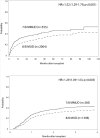HLA Mismatch Is Associated with Worse Outcomes after Unrelated Donor Reduced-Intensity Conditioning Hematopoietic Cell Transplantation: An Analysis from the Center for International Blood and Marrow Transplant Research
- PMID: 26055300
- PMCID: PMC4568127
- DOI: 10.1016/j.bbmt.2015.05.028
HLA Mismatch Is Associated with Worse Outcomes after Unrelated Donor Reduced-Intensity Conditioning Hematopoietic Cell Transplantation: An Analysis from the Center for International Blood and Marrow Transplant Research
Abstract
Over the past 2 decades, reduced-intensity conditioning allogeneic hematopoietic cell transplantation (RIC HCT) has increased substantially. Many patients do not have fully HLA-matched donors, and the impact of HLA mismatch on RIC HCT has not been examined in large cohorts. We analyzed 2588 recipients of 8/8 HLA-high resolution matched (n = 2025) or single-locus mismatched (n = 563) unrelated donor (URD) RIC HCT from 1999 to 2011. Overall survival (OS) was the primary outcome. Secondary endpoints included treatment-related mortality (TRM), relapse, disease-free survival (DFS), and acute/chronic graft-versus-host disease (GVHD). Adjusted 1- and 3-year OS was better in 8/8- versus 7/8-matched recipients (54.7% versus 48.8%, P = .01, and 37.4% versus 30.9%, P = .005, respectively). In multivariate models 7/8 URD RIC HCT recipients had more grades II to IV acute GVHD (RR = 1.29, P = .0034), higher TRM (RR = 1.52, P < .0001), and lower DFS (RR = 1.12, P = .0015) and OS (RR = 1.25, P = .0001), with no difference in relapse or chronic GVHD. In subgroup analysis, inferior transplant outcomes were noted regardless of the HLA allele mismatched. Previously reported permissive mismatches at HLA-C (C*03:03/C*03:04) and HLA-DP1 (based on T cell-epitope matching) were not associated with better outcomes. Although feasible, single-locus mismatch in RIC URD HCT is associated with inferior outcomes.
Keywords: Bone marrow transplantation; Hematologic malignancies; Leukemia; Pediatric oncology.
Copyright © 2015 American Society for Blood and Marrow Transplantation. All rights reserved.
Figures
References
-
- Foeken LM, Green A, Hurley CK, et al. Monitoring the international use of unrelated donors for transplantation: the WMDA annual reports. Bone Marrow Transplant. 2010;45:811–818. - PubMed
-
- Petz LD SS, Gragert L. Cord Blood: Biology, Transplantation, Banking, and Regulation. Vol. 1. AABB Press; 2011. The underutilization of cord blood transplantation: extent of the problem, causes, and methods improvement; pp. 557–584.
-
- Morishima Y, Sasazuki T, Inoko H, et al. The clinical significance of human leukocyte antigen (HLA) allele compatibility in patients receiving a marrow transplant from serologically HLA-A, HLA-B, and HLA-DR matched unrelated donors. Blood. 2002;99:4200–4206. - PubMed
-
- Sasazuki T, Juji T, Morishima Y, et al. Effect of matching of class I HLA alleles on clinical outcome after transplantation of hematopoietic stem cells from an unrelated donor. Japan Marrow Donor Program. N Engl J Med. 1998;339:1177–1185. - PubMed
-
- Lee SJ, Klein J, Haagenson M, et al. High-resolution donor-recipient HLA matching contributes to the success of unrelated donor marrow transplantation. Blood. 2007;110:4576–4583. - PubMed
MeSH terms
Substances
Grants and funding
LinkOut - more resources
Full Text Sources
Other Literature Sources
Research Materials
Miscellaneous


